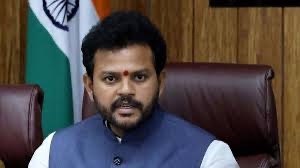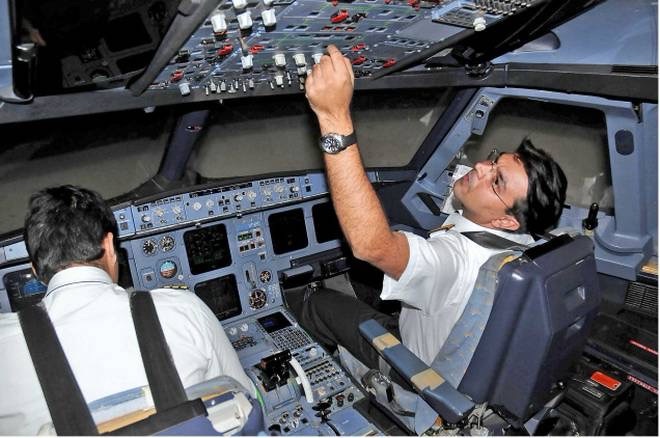To ensure the efficient operation of an aircraft adhering to a structured timetable, a minimum of 10 to 15 pilots per aircraft is necessary, thereby facilitating the execution of scheduled routes.
According to Union Civil Aviation Minister K Ram Mohan Naidu, India will necessitate an additional 30,000 pilots upon the delivery of the 1,700 aircraft currently ordered by Indian carriers, as stated on Saturday.
In his address during a session at the CII Partnership Summit, Naidu indicated that, akin to FedEx, a global logistics enterprise with a dedicated airport in the United States, the central government is contemplating the establishment of cargo airports within the nation.
Naidu further emphasized that India presently possesses approximately 8,000 pilots for a fleet comprising 834 aircraft, with an estimated 2,000 to 3,000 pilots not actively engaged in flying operations. Indian carriers have formally placed orders for 1,700 aircraft from manufacturers such as Boeing and Airbus.

To effectively operate an aircraft under a structured schedule, it is essential to have a minimum of 10 to 15 pilots assigned to each aircraft, enabling them to fulfill scheduled routes.
Thus, with 1,700 aircraft requiring 10 to 15 pilots each, the projected demand would range from 25,000 to 30,000 pilots. This anticipated demand is poised to materialize. As these aircraft are introduced into service, one must consider the requisite of 30,000 pilots, as articulated by Naidu.
To satisfy this burgeoning demand, an increase in the number of Flying Training Organizations (FTOs) is imperative, as the current establishments yield only a limited output of trained pilots.
The minister highlighted that each employment opportunity within the Indian aviation industry generates approximately 15 indirect jobs, contrasting with the International Air Transport Association’s (IATA) estimate of 6 indirect jobs.
“It is of paramount importance for us to equip our workforce through comprehensive training and to establish a well-structured skilling ecosystem within the nation,” he remarked.
Naidu additionally noted that the aviation cargo sector is encountering formidable competition from rail and road transport, which are more cost-effective, while airport operators prioritize enhancements to passenger amenities, consequently relegating cargo operations.
As reported by the minister, Indian manufacturers currently produce aerospace components valued at USD 2 billion, with aspirations to escalate this figure to USD 4 billion by the year 2030, a target that remains well within reach.
The central government envisions a long-term objective of achieving the design and manufacturing of complete aircraft entirely within the country.
“It has been a longstanding aspiration, yet there has been insufficient progress in addressing existing gaps. However, we now recognize that India has reached a pivotal stage where we possess the capability to manufacture, design, and maintain our own aircraft. This is a critical area on which we are diligently focusing,” Naidu asserted.

The Aviation Minister noted that, on average, approximately 480,000 individuals are airborne daily within the country, with a notable peak of 530,000 passengers recorded on November 10, which constitutes a significant achievement.
A New Airport Every 50 Days
India’s aviation industry is experiencing remarkable expansion, with a new airport becoming operational every 50 days, as stated by Civil Aviation Minister K Ram Mohan Naidu. This progress highlights the significant achievements in increasing passenger capacity and improving aviation infrastructure.
During the 30th CII Partnership Summit-2025, Naidu pointed out that Andhra Pradesh is leading this growth, currently hosting seven operational airports and planning additional ones. The state also intends to establish flight-training organizations and an aviation skilling university in Visakhapatnam.
The minister disclosed plans to enhance the drone sector by creating a dedicated drone city, alongside advancing aerospace and aircraft manufacturing, thereby positioning the state as a frontrunner in the aviation field.
He mentioned that the state presently has seven airports and aims to add seven more, signifying a substantial enhancement in regional air connectivity. In conjunction with airports, Andhra Pradesh is also focused on developing a robust aviation infrastructure to facilitate training, maintenance, and manufacturing.
“We have four flight training organizations being established in the state. We have an MRO ecosystem developing in Visakhapatnam. We are also establishing an aviation skilling university in Visakhapatnam,” he remarked, stressing the comprehensive strategy to build a complete aviation ecosystem.
He additionally noted that the government is expanding the drone sector and constructing a “drone city,” while also significantly promoting aerospace and aircraft manufacturing throughout the nation.

Discussing India’s long-term vision, the minister expressed that the year 2047 should be regarded not as a challenge but as a time of vast opportunities.
“2047 is not a challenge for the country, but rather an abundance of opportunities available to us. Today, Andhra Pradesh is capitalizing on all the possibilities that lie before us,” he stated.
He credited this advancement to the strength of the “double-engined Sarkar,” where both state and central governments collaborate with unity, clarity, and determination. “When the state government and central government unite with clarity and conviction, the strength that is demonstrated is evident today in Andhra Pradesh,” he added.
For all aviation-related guidance (DGCA ground classes, pilot training, cabin crew training)
Contact us https://contrail.in/
phone numbers +91 78457 69399


